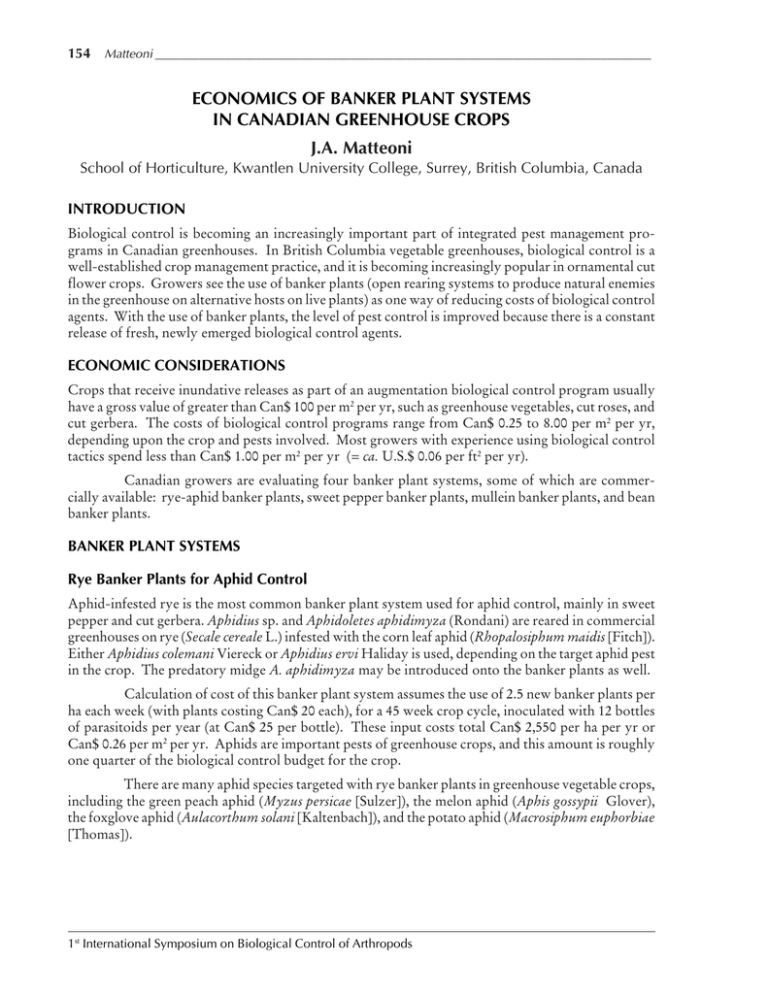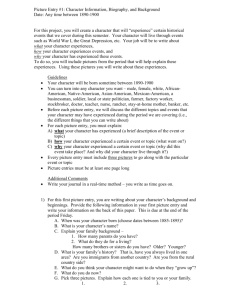ECONOMICS OF BANKER PLANT SYSTEMS IN CANADIAN GREENHOUSE CROPS J.A. Matteoni
advertisement

154 Matteoni _______________________________________________________________________________ ECONOMICS OF BANKER PLANT SYSTEMS IN CANADIAN GREENHOUSE CROPS J.A. Matteoni School of Horticulture, Kwantlen University College, Surrey, British Columbia, Canada INTRODUCTION Biological control is becoming an increasingly important part of integrated pest management programs in Canadian greenhouses. In British Columbia vegetable greenhouses, biological control is a well-established crop management practice, and it is becoming increasingly popular in ornamental cut flower crops. Growers see the use of banker plants (open rearing systems to produce natural enemies in the greenhouse on alternative hosts on live plants) as one way of reducing costs of biological control agents. With the use of banker plants, the level of pest control is improved because there is a constant release of fresh, newly emerged biological control agents. ECONOMIC CONSIDERATIONS Crops that receive inundative releases as part of an augmentation biological control program usually have a gross value of greater than Can$ 100 per m2 per yr, such as greenhouse vegetables, cut roses, and cut gerbera. The costs of biological control programs range from Can$ 0.25 to 8.00 per m2 per yr, depending upon the crop and pests involved. Most growers with experience using biological control tactics spend less than Can$ 1.00 per m2 per yr (= ca. U.S.$ 0.06 per ft2 per yr). Canadian growers are evaluating four banker plant systems, some of which are commercially available: rye-aphid banker plants, sweet pepper banker plants, mullein banker plants, and bean banker plants. BANKER PLANT SYSTEMS Rye Banker Plants for Aphid Control Aphid-infested rye is the most common banker plant system used for aphid control, mainly in sweet pepper and cut gerbera. Aphidius sp. and Aphidoletes aphidimyza (Rondani) are reared in commercial greenhouses on rye (Secale cereale L.) infested with the corn leaf aphid (Rhopalosiphum maidis [Fitch]). Either Aphidius colemani Viereck or Aphidius ervi Haliday is used, depending on the target aphid pest in the crop. The predatory midge A. aphidimyza may be introduced onto the banker plants as well. Calculation of cost of this banker plant system assumes the use of 2.5 new banker plants per ha each week (with plants costing Can$ 20 each), for a 45 week crop cycle, inoculated with 12 bottles of parasitoids per year (at Can$ 25 per bottle). These input costs total Can$ 2,550 per ha per yr or Can$ 0.26 per m2 per yr. Aphids are important pests of greenhouse crops, and this amount is roughly one quarter of the biological control budget for the crop. There are many aphid species targeted with rye banker plants in greenhouse vegetable crops, including the green peach aphid (Myzus persicae [Sulzer]), the melon aphid (Aphis gossypii Glover), the foxglove aphid (Aulacorthum solani [Kaltenbach]), and the potato aphid (Macrosiphum euphorbiae [Thomas]). 1st International Symposium on Biological Control of Arthropods ___________________________ Economics of banker plant systems in Canadian greenhouse crops 155 Disadvantages of this system are potential infestation of monocot crop plants (e.g., lilies) by the aphid R. maidis and development of powdery mildew on the rye plants. Rye plants may also host two other greenhouse pest species, Frankliniella intonsa (Trybom) and F. occidentalis (Pergande). Commercially available banker plants use rye cultivars that are resistant to mildew. Sweet Pepper Banker Plants for Aphid Control Some growers are experimenting with using sweet pepper (Capsicum annum L.) as trap plants for aphids in crops such as cut Lisianthus sp., Matthiola sp., and Alstroemeria sp. Once the aphids are found on the pepper plants, the aphid parasitoids Aphidius sp. are introduced, and the pepper trap plants become banker plants. The predatory midge A. aphidimyza may also be introduced and reared on the same banker plants. The availability of inexpensive, surplus pepper plants from greenhouse vegetable propagators makes this system appealing to growers, although efficacy data is anecdotal. The principal aphids targeted with the approach are the green peach aphid and the melon aphid. Mullein Banker Plants Infested with the Whitefly Predator Dicyphus hesperus The predatory bug Dicyphus hesperus Knight can complete its life cycle on common mullein (Verbascum thapsus L.) in the absence of prey. Also, the lifespan of D. hesperus is greatly increased when reared on mullein. These characteristics are used to help establish the predator in tomato crops, where the predator then feeds on greenhouse whitefly (Trialeurodes vaporariorum [Westwood]). A single introduction of mullein plants into the crop early in the season is recommended at a rate of 100 mullein plants per ha of crop. The mullein plants are available at a cost of Can$ 1.00 to 1.50 per plant depending upon plant size. The predator costs Can$ 100 per 250 D. hesperus, and should be released on banker plants four times to ensure establishment. Assuming an average cost per banker plant of Can$ 1.25, use of 100 plants per ha; and four introductions of 250 Dicyphus at Can$ 100 each, the cost of this biological control system for one growing season is approximately Can$ 0.05 per m2 per year. This banker plant system is still being studied but is becoming more popular since its inception by the original researchers, Dave Gillespie and Rob McGregor (Agriculture and Agrifood Canada), and two private consultants. Anecdotal evidence suggests that the omnivorous predator D. hesperus can contribute to control of western flower thrips, Frankliniella occidentalis (Pergande), and twospotted spider mite, Tetranychus urticae Koch, in greenhouse tomatoes. Bush Bean Banker Plants for Mite Predators Bush bean plants (Phaseolus vulgaris L.) are useful for the early detection of two-spotted spider mites in greenhouse tomato crops in early spring. Once the bean plants become infested with spider mites, they are inoculated with the predatory mite Phytoseiulus persimilis Athias-Henriot. The plants then serve as banker plants for predatory mites. The bush beans are planted into the growing medium as germinating seeds or seedlings, in locations where two-spotted mite infestations occurred the previous season. Seeds are planted at a spacing of approximately one bean seed per running meter of crop row. This system is not widely used because of some potential complications: movement of thrips from the banker plants onto the tomatoes, development of high pest populations if bean plants are neglected, and interference with growing systems in the proximity of the bean plants. The cost of this system would be based upon the cost of bean seed and P. persimilis for inoculum. 1st International Symposium on Biological Control of Arthropods





